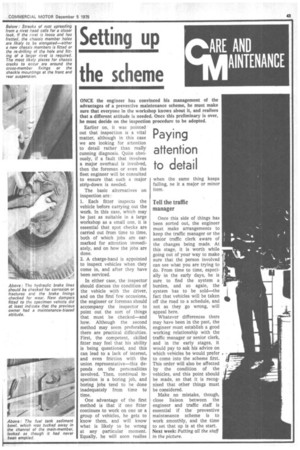Setting up the scheme
Page 45

If you've noticed an error in this article please click here to report it so we can fix it.
ONCE the engineer has convinced his management of the advantages of a preventive maintenance scheme, he must make sure that everyone in the workshop knows about it, and realises that a different attitude is needed. Once this preliminary is over, he must decide on the inspection procedure to be adopted.
Earlier on, it was pointed out that inspection is a vital matter, although in this case we are looking for attention to detail rather than really cunning diagnosis. Quite obviously, if a fault that involves a major overhaul is involved, then the foreman or even the fleet engineer will be consulted to ensure that such a major strip-down is needed.
The basic alternatives on inspection are: 1. Each fitter inspects the vehicle before carrying out the work. In this case, which may be just as suitable in a large workshop as a small one, it is essential that spot checks are carried out from time to time, both of which jobs are earmarked for attention immediately, and on how the jobs are done.
2. A charge-hand is appointed to inspect vehicles when they come in, and after they have been serviced.
In either case, the inspector should discuss the condition of the vehicle with 'the driver, and on the first few occasions, the engineer or foreman should accompany the inspector to point out the sort of things that must be checked—and how. Although the second method may seem preferable, there are practical difficulties. First, the competent, skilled fitter may feel that his ability is being questioned, and this can lead to a lack of interest, and even friction with the union representative—this depends on the personalities involved. Then, continual inspection is a boring job, and boring jobs tend to be done inadequately from time to time.
One advantage of the first method is that if one fitter continues to work on one or a group of vehicles, he gets to know them, and will know what is likely to be wrong at any particular moment. Equally, he will soon realise


































































































































